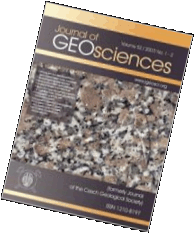 Export to Mendeley
Export to MendeleyOriginal paper
Low overvoltage approach for reduction of the analytical volume in electron probe microanalysis: A case study of sulfide assemblages in enstatite-rich meteorites
Journal of Geosciences, volume 70 (2025), issue 1, 15 - 31
DOI: http://doi.org/10.3190/jgeosci.402
Among enstatite-rich meteorites are included enstatite chondrites and enstatite achondrites (aubrites). The reducing conditions of origin are reflected in their mineralogy. Due to the lack of oxygen-bearing mineral assemblages allowing the application of traditional geothermometers, sulfides are used as a tool to constrain the conditions of their origin. In general, sulfide-based geothermometers rely on the contents of major or minor elements traditionally determined by electron probe microanalysis. This method requires the analyzed material to be a homogenous single phase in the analytical volume. However, sulfides of enstatite-rich meteorites frequently contain tiny lamellar inclusions of different phases, and therefore, the inclusions might affect the overall composition of sulfides. Consequently, the results of such analyses might influence the estimates of the conditions under which the given meteorite formed. This study discusses the effect of using the low-overvoltage approach to analyze iron and nickel (10 kV) in the primary sulfides of enstatite-rich meteorites and how results compare to those obtained with the traditional analytical protocol (20 kV). The sulfides analyzed included Cr-Ti-bearing troilite, daubréelite (FeCr2S4), and (Mg,Fe,Mn)S-monosulfide. Unfortunately, troilite often contains lamellar inclusion of daubréelite. Moreover, troilite inclusions are occasionally also included in (Mg,Fe,Mn)S-monosulfide. Therefore, obtaining an unbiased analysis of these minerals is intricate. Due to this, the main objective of using a lower accelerating voltage is to reduce the analytical volume to the minimum to increase the probability of avoiding tiny inclusions. Even if the analytical volume is inclusion-free, another complication might occur as the analysis of troilite may be affected by the neighboring daubréelite due to boundary fluorescence. Consequently, both phenomena bias the Cr content measured in troilite similarly, and due to the complexity of troilite-daubréelite assemblage, it is nearly impossible to quantify the amount of Cr content unbiased. Subsequently, to obtain the best possible dataset, precise sample screening and careful analytical point location setting are required in general. Using lower accelerating voltage brings many advantages as it allows better observation of the inclusions, and due to reducing the analytical volume, it reduces the chance of the presence of inclusions and suppresses the bias in Cr from boundary fluorescence. However, it also has disadvantages as the analysis is not trivial and does not favor trace elements analysis in general. Results demonstrate the importance of point-by-point inspection of the acquired data and subsequent elimination of biased analyses from the final datasets.
Webdesign inspired by aTeo. Hosted at the server of the Institute of Petrology and Structural Geology, Charles University, Prague.
ISSN: 1803-1943 (online), 1802-6222 (print)
email: jgeosci(at)jgeosci.org


IF (WoS, 2024): 1.3
5 YEAR IF (WoS, 2024): 1.4
Policy: Open Access
ISSN: 1802-6222
E-ISSN: 1803-1943